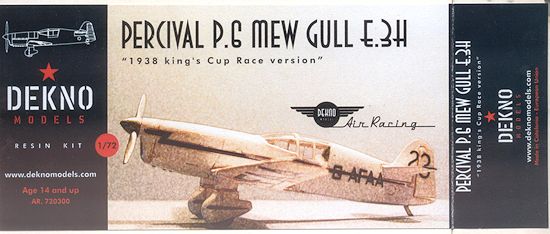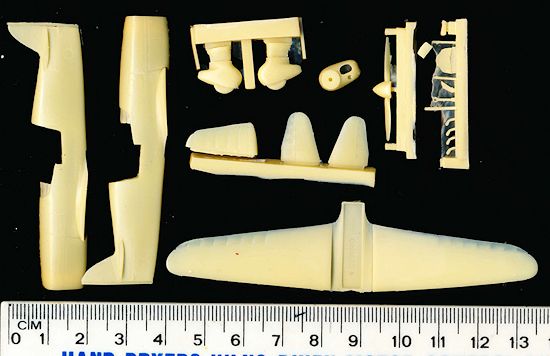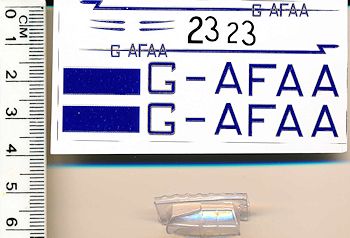
Dekno 1/72 Mew Gull E.3H
| KIT #: | 720300 |
| PRICE: |
24 Euro direct from Dekno |
| DECALS: | One Option |
| REVIEWER: | Peter Burstow |
| NOTES: |
Resin kit with vac canopy |

| HISTORY |
Designed by Captain Edgar Percival
for racing, 6 Mew Gulls were built from 1934 to 1937. All the Mew Gulls were
custom built for different customers, so had a variety of engines including
Napier Javelin, Regneir, de Havilland Gypsy Six, and Gypsy Six series 2. There
were also differences in structure and wing span between the models.
The subject of
the kit, Mew Gull E3H G-AFAA was Captain Edgar Percival's personal “Super” Mew
Gull. Built in 1937 at Luton, it had a superficial resemblance to the earlier
Mew Gulls but was substantially different. It had a more powerful engine and
smaller wing span, altogether faster with a higher climb rate and longer range.
It was written off when on loan to de Havilland for propeller trials during the
Second World War, and was burnt at a garden fete after the war.
| THE KIT |
 Coming in a small but very strong end
opening box, there are 18 cream coloured resin parts, and a vac-formed canopy
(sorry Scott).
The parts are packed in a small
segmented plastic bag to minimise scratching. My kit had the seat back broken
off, but no other damage, though the rudder had separated from the pouring stub.
The parts have a smooth surface finish, as befits a
wooden aircraft, but are slightly rough around the edges. The control surfaces
will need special care when cleaning up as they are finely detailed and thin
enough to be translucent. There are very fine but soft engraved panel lines.
Coming in a small but very strong end
opening box, there are 18 cream coloured resin parts, and a vac-formed canopy
(sorry Scott).
The parts are packed in a small
segmented plastic bag to minimise scratching. My kit had the seat back broken
off, but no other damage, though the rudder had separated from the pouring stub.
The parts have a smooth surface finish, as befits a
wooden aircraft, but are slightly rough around the edges. The control surfaces
will need special care when cleaning up as they are finely detailed and thin
enough to be translucent. There are very fine but soft engraved panel lines.
Cockpit detail is sparse, with a car
like seat, a control stick and an instrument panel. A bit more detail may be
wanted as there is a relatively large cockpit opening and the vac-formed canopy
is very clear.
 G-AFAA was all
white, with blue and gold trim and an aluminium prop and spinner. The decals are
for G-AFAA only and are printed in dark blue and gold. The include all the
serials and the trim. Spare patches of blue are provided with instructions on
doing the wing tip trim. They look very attractive and but do have a slight
registration problem.
G-AFAA was all
white, with blue and gold trim and an aluminium prop and spinner. The decals are
for G-AFAA only and are printed in dark blue and gold. The include all the
serials and the trim. Spare patches of blue are provided with instructions on
doing the wing tip trim. They look very attractive and but do have a slight
registration problem.
The instructions are a single sheet of A5, clearly printed on both sides in English, showing 4 construction steps, painting and decalling guide, and a short history. It includes paint references with Humbrol numbers only for the internal cockpit (what is #78?), white and polished aluminium exterior.
| CONCLUSIONS |
| REFERENCES |
http://en.wikipedia.org/wiki/Percival_Mew_Gull
A.J. Jackson,
British Civil Aircraft 1919-1972: Volume III. Putnam, London, 1974. - Has
photographs of three of the Mew Gulls.
Alex Henshaw,
The Flight of the Mew Gull. Hamlyn, London 1980 - Has a number of photographs of
G-AEXF including cockpit close ups.
Kit Instructions.
February 2013
If you would like your product reviewed fairly and fairly quickly, please contact the editor or see other details in the Note to Contributors.